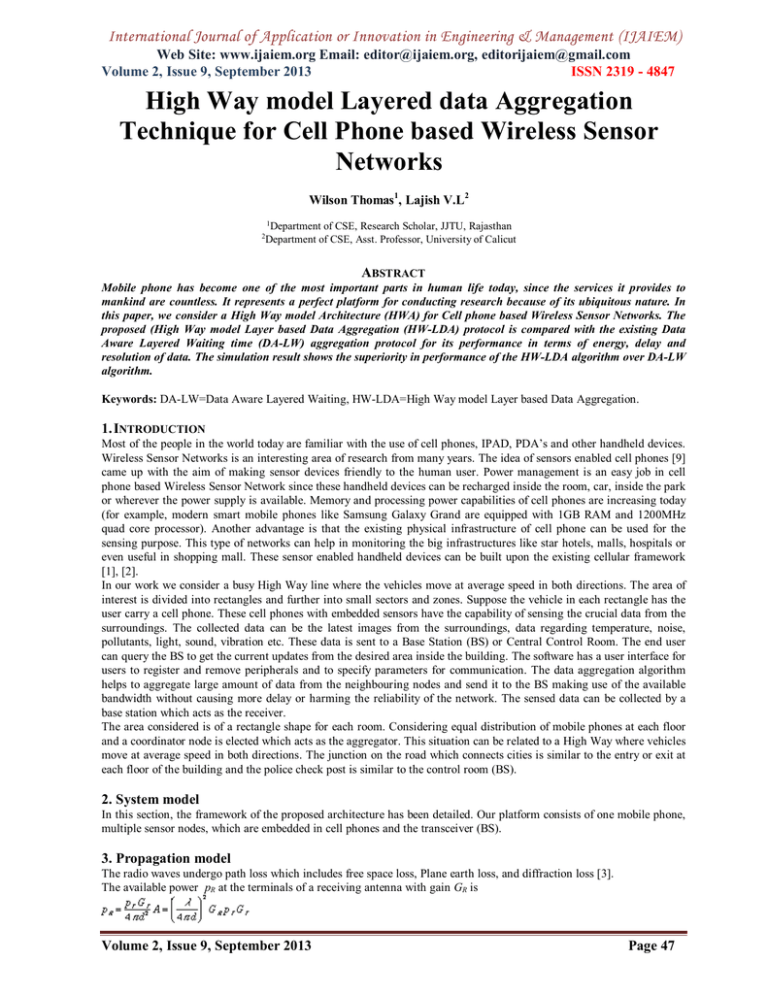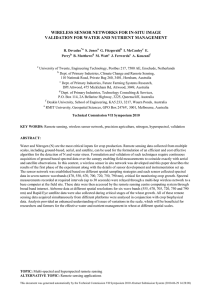International Journal of Application or Innovation in Engineering & Management... Web Site: www.ijaiem.org Email: , Volume 2, Issue 9, September 2013
advertisement

International Journal of Application or Innovation in Engineering & Management (IJAIEM) Web Site: www.ijaiem.org Email: editor@ijaiem.org, editorijaiem@gmail.com Volume 2, Issue 9, September 2013 ISSN 2319 - 4847 High Way model Layered data Aggregation Technique for Cell Phone based Wireless Sensor Networks Wilson Thomas1, Lajish V.L2 2 1 Department of CSE, Research Scholar, JJTU, Rajasthan Department of CSE, Asst. Professor, University of Calicut ABSTRACT Mobile phone has become one of the most important parts in human life today, since the services it provides to mankind are countless. It represents a perfect platform for conducting research because of its ubiquitous nature. In this paper, we consider a High Way model Architecture (HWA) for Cell phone based Wireless Sensor Networks. The proposed (High Way model Layer based Data Aggregation (HW-LDA) protocol is compared with the existing Data Aware Layered Waiting time (DA-LW) aggregation protocol for its performance in terms of energy, delay and resolution of data. The simulation result shows the superiority in performance of the HW-LDA algorithm over DA-LW algorithm. Keywords: DA-LW=Data Aware Layered Waiting, HW-LDA=High Way model Layer based Data Aggregation. 1. INTRODUCTION Most of the people in the world today are familiar with the use of cell phones, IPAD, PDA’s and other handheld devices. Wireless Sensor Networks is an interesting area of research from many years. The idea of sensors enabled cell phones [9] came up with the aim of making sensor devices friendly to the human user. Power management is an easy job in cell phone based Wireless Sensor Network since these handheld devices can be recharged inside the room, car, inside the park or wherever the power supply is available. Memory and processing power capabilities of cell phones are increasing today (for example, modern smart mobile phones like Samsung Galaxy Grand are equipped with 1GB RAM and 1200MHz quad core processor). Another advantage is that the existing physical infrastructure of cell phone can be used for the sensing purpose. This type of networks can help in monitoring the big infrastructures like star hotels, malls, hospitals or even useful in shopping mall. These sensor enabled handheld devices can be built upon the existing cellular framework [1], [2]. In our work we consider a busy High Way line where the vehicles move at average speed in both directions. The area of interest is divided into rectangles and further into small sectors and zones. Suppose the vehicle in each rectangle has the user carry a cell phone. These cell phones with embedded sensors have the capability of sensing the crucial data from the surroundings. The collected data can be the latest images from the surroundings, data regarding temperature, noise, pollutants, light, sound, vibration etc. These data is sent to a Base Station (BS) or Central Control Room. The end user can query the BS to get the current updates from the desired area inside the building. The software has a user interface for users to register and remove peripherals and to specify parameters for communication. The data aggregation algorithm helps to aggregate large amount of data from the neighbouring nodes and send it to the BS making use of the available bandwidth without causing more delay or harming the reliability of the network. The sensed data can be collected by a base station which acts as the receiver. The area considered is of a rectangle shape for each room. Considering equal distribution of mobile phones at each floor and a coordinator node is elected which acts as the aggregator. This situation can be related to a High Way where vehicles move at average speed in both directions. The junction on the road which connects cities is similar to the entry or exit at each floor of the building and the police check post is similar to the control room (BS). 2. System model In this section, the framework of the proposed architecture has been detailed. Our platform consists of one mobile phone, multiple sensor nodes, which are embedded in cell phones and the transceiver (BS). 3. Propagation model The radio waves undergo path loss which includes free space loss, Plane earth loss, and diffraction loss [3]. The available power pR at the terminals of a receiving antenna with gain GR is Volume 2, Issue 9, September 2013 Page 47 International Journal of Application or Innovation in Engineering & Management (IJAIEM) Web Site: www.ijaiem.org Email: editor@ijaiem.org, editorijaiem@gmail.com Volume 2, Issue 9, September 2013 ISSN 2319 - 4847 Where A is the aperture of the antenna and carrier frequency. . The wavelength = c / fc with c the velocity of light and fc the 4. Energy model of mobile phones The mobile phone battery is consumed mainly for making and receiving calls or other user personal use apart from the energy spent for sensing. The instantaneous charge(t1) the cell phone carries is given by:charge(t1)=charge(t)-[charge(t2)+charge(t3)] Where charge(t) is the total charge the cell phone carries in the initial stage, charge(t2) is the energy spent for making and receiving calls and charge(t3) is the energy spent for sensing and transmission. 5 High Way model Layering Architecture The area considered is assumed to be rectangular in shape for simplicity. The cellular networks (2.5G, 3G, 4G) provides seamless and secure mobility [6][7]. The Random waypoint mobility model [8] describes the movement pattern of mobile users in cellular networks. In the proposed model the area of interest is divided into N rectangles of equal dimensions, each having equal distribution of cell phones. This model is proposed with the following aims: 1. Support high mobility situation. Mobility is advantageous since it yields significant advantage in spatial coverage 2. The current technologies like 2G, 3G, and future 5G can be incorporated. 3. Cell phones can be even powered from solar energy. 4. Human user can carry a cell phone which is rechargeable. In cell phone based WSN it is possible for the mobile users to concentrate on the area of interest unlike the traditional sensor networks. There are three logical layers involved in cell phone based sensor networks [4]. 1. Lower layer – wireless sensor networks for monitoring and reporting objects: information (eg. Temperature, humidity) 2. Middle layer – wireless mesh network for transmitting sensed data in long distance and reliable way. 3. Upper layer – Internet for users to remotely access sensed data. Figure 3 Figure 3 shows the proposed architecture where the vehicles are moving in a busy high way. This architecture can be simulated by considering the N rectangles (numbered 1, 2, 3... in the figure 3). 6. Simulation Results and Discussion The simulation of project is carried out using OMNeT++ 4.2b simulator with INET framework. The application layer is the upper layer and transportation and network layer acts as the middle layer and data link and physical layer is the lower layer. The simulations have been performed for 500 nodes deployed in a rectangular area. The velocity range is 0.01-9.99 m/s. Total 5 layers are considered and the battery range is 3.7×1250 mAh. The users can recharge the battery, if the charge falls by 0.2×battery rating. The cell phone receiver sensitivity is chosen to be -60dBm. The data collection is done at 10 minutes intervals. The performance is evaluated using graphs obtained [5]. Figure 1 shows the average power consumption of a sensor node with different communication intervals. As the communication interval is increased from 15 seconds to 5 minutes, the average power consumption deceases from 20mW to 2mW.Figure 2 shows the average power consumption versus communication interval in case of data collected from DA-LW algorithm. It is obvious that in this case the when the communication interval is increased the average power consumption is steadily constant at around 3.5mW which is slightly higher than HWA algorithm. Volume 2, Issue 9, September 2013 Page 48 International Journal of Application or Innovation in Engineering & Management (IJAIEM) Web Site: www.ijaiem.org Email: editor@ijaiem.org, editorijaiem@gmail.com Volume 2, Issue 9, September 2013 ISSN 2319 - 4847 7. Conclusion and future work We have presented a High Way model Layered data aggregation technique suitable for a big infrastructure. The simulation results show the domination of the proposed protocol over the existing DA-LW protocol. Other aspects of these algorithms related to varying transmission ranges, load balancing and packet loss need to be further analyzed. References [1] A. Kansal, M. Gorzko, and F. Zaho. Building a sensor network of mobile phones. ISPN ’07, April 2007. [2] J.Burke, D. Estrin, M. Hansen, A.Parker, N. Ramanathan, S. Reddy, and M. B. Srivasthava. Participatory sensing. WSN 06 at SenSys ’06, 51(11):1927-48, November 2003. [3] Jean-Paul M. G. Linmartz's Wireless Communication, The Interactive Multimedia CD-ROM, Baltzer Science Publishers, P.O.Box 37208, 1030 AE Amsterdam, ISSN 1383 4231, Vol. 1 (1996), No.1 [4] P. Kalyani, Heterogeneous Wireless Mobile Sensor Network Model Based Routing Adopted to Dynamic Topology, European Journal of Scientific Research ISSN 1450-216X Vol.50 No.1 (2011), pp.143-150 [5] Layered Data Aggregation in Cell-Phone based Wireless Sensor Networks Deepthi Chander, Bhushan Jagyasi, U. B. Desai, S. N. Merchant SPANN Laboratory, Electrical Engineering Department, Indian Institute of Technology, Bombay. pp. 6-7. [6] Frederic Paint, Paal Engelstad, Erik Vanem, Thomas Haslestad, Anne Mari Nordvik, Kjell Myksvoll, Stein Svaet, “Mobility aspects in 4G Networks- White Paper [7] Ramjee et al. HAWAII: A Domain-based Approach for Supporting Mobility in Wide-area Wireless Networks , International Conference on Network Protocols, ICNP'99, June 1999. [8] C. Bettstetter, H. Hartenstein, and X. Pérez-Costa. Stochastic properties of the random waypoint mobility model. ACM/Kluwer Wireless Networks: Special Issue on Modeling and Analysis of Mobile Networks, 10(5), September 2004 [9] Urban Computing and Information Management System Using Mobile Phones in Wireless Sensor Network Kheyali Mitra1, Debnath Bhattacharyya2, and Tai-hoon Kim2, International Journal of Control and Automation Vol. 3, No. 1, March, 2010 Volume 2, Issue 9, September 2013 Page 49







